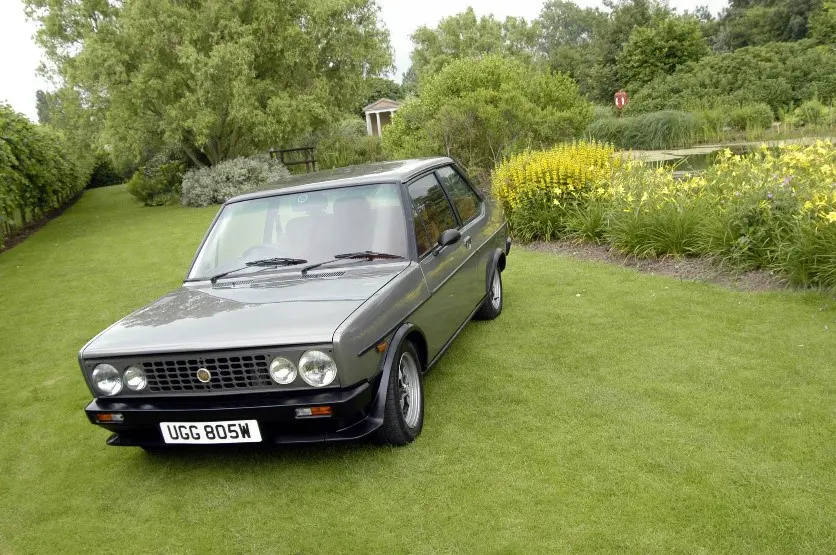THE FIAT 131 AT 50 By Andrew Roberts
05 August 2024
It is always a pleasant experience to be reacquainted with Theo Kyriacou’s Sport, which goes by the Nom-de-Fiat of Hugo. This is the version of the 131 family that prompted Car magazine to write: “As far as hotshoe saloons go, Ford have been building the best for upwards of five years, and it is probably time they were bettered. That, Fiat has duly done.” But then, any example of the 131 is now an exclusive sight.

Fiat introduced the 131 Mirafiori (named after the factory’s location) at the 1974 Turin Motor Show, and their proclamation was a true gem of ‘sales speak’:
“Danger exists and will not be overcome by resignation and inertia. At precisely this time, the new Fiat is born, a tangible testimony of the duty, the application and the validity of the work of the motor car business, an act of faith, a point of departure towards tomorrow. The relationship between man and car has changed, but the need for transport and individual mobility are indispensable prerequisites of liberty and civilisation.”
All of this was a long-winded method of telling the world about the replacement of the Fiat 124. The bodyshell of its predecessor would last for several more decades in overseas factories.
When UK sales began in 1975, prices ranged from £1,619 for the two-door 1300 saloon to £2,080 for the five-door estate; buyers could also choose four-door bodywork. The 131 competed with the Ford Cortina Mk. III while Richard Hudson-Evans on Thames TV’s Drive In referred to it as an “Italian Marina”.
This was not an unfair comparison, for, as with the Morris, the 131 was a deliberately innocuous-looking saloon; the Italian bourgeois preferred low-key styling. However, the Fiat offered the discerning motorist a sense of verve. As a June 1975 Car group test put it, the 131 was “just about the best compromise possible between brio and the tin box”. The great L.J.K. Setright went so far as to praise the 1300 version’s:
“Astonishing refinement, forgiving handling, remarkable economy, ample room, elegant mechanical detail, a two-year guarantee against rust – all make it better than any fancy front-driver and much better than other rear-drive tin boxes.”
Fiat facelifted the range in 1978 as the Supermirafiori with new DHOC engines. One famous advertising campaign featured a four-door model in a tiger cage while snarling, “Grrr!”. The copy, which anticipated Gareth Cheeseman by over 15 years, warned: “This handsome animal is the Supermirafiori, bred in Italy by Fiat. Don’t be fooled by its sleek looks...underneath that beautiful body lurks an angry beast”.
Because (or even despite) such advertising, the Supermirafiori gained a following among drivers who wished to resemble Vittorio Gassman when they visited their local Wavy Line store. That year, Fiat GB tempted Ford Escort RS2000 owners with the Sport, powered by a 1,995cc belt-driven twin-cam engine. It was known as the “Racing” on the continent, but Fiat thought this name would be “a licence for trouble” in the UK; they aimed the Sport at well-heeled motorists rather than ageing ‘Ton Up boys’.
The sales copy promised a top speed of 110 mph, while your £4,346 gained you a five-speed transmission, quad headlamps, a front air dam and a mesh radiator grille. The Sport also boasted rather fabulous suede-like upholstery, and buyers could select orange, silver, or metallic grey as the colour choices. The Daily Telegraph complained, “One of the unfortunate obsessions of the Italian motorist is his belief that any car with sporting pretensions has to be noisy as well as quick”. That said, the Sport was “so eager to go that it tends to be driven quickly most of the time”.
Fiat modified the range in 1981, with Fiat GB continuing to target Cortina owners:
Production of the saloon ended in 1983, with the ‘Panorama’ estate lasting until the following year; the Mirafiori enjoyed an extensive postscript, the Turkish variants lasting until 2002, and a version was built in Ethiopia as recently as 2010.
And perhaps the 131’s appeal is summarised by the advertisement that claimed: “We put excitement into sensible cars”. Absolutely.
With thanks to: Theo Kyriacou and Fiat Motor Club
